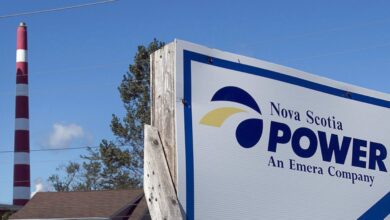Nova Scotia cancer patients to be treated with new radiotherapy technology

Some Nova Scotians who are battling cancer will soon be able to cut down on the number of radiotherapy treatments they receive.
On Jan. 3, Ethos radiotherapy system with HyperSight imaging solution – a system powered by artificial intelligence – will be used to treat the first patient in Nova Scotia.
Dr. Helmut Hollenhorst, senior medical director of the Nova Scotia Cancer Care Program, said the system allows health-care workers to target tumour sites while protecting surrounding healthy organs from potential damage.
“If we take a static image to plan and deliver our radiation therapy, it’s a risk to miss the target,” Hollenhorst said at a news conference at the Nova Scotia Health Innovation Hub in downtown Halifax on Wednesday.
“So, what we have done in the past is just apply larger margins, regardless of where that organ would be on a particular day or time of the day, it would be included in the radiation therapy field anyway.
“So, with this new technology, we actually can instantly scan our patients in just six seconds and artificial intelligence will adjust and adapt the previous treatment plan to best fit and form the dose and distribution around the tumour.”
Hollenhorst said for some patients, this means their typical standard course of 20 radiotherapy sessions can be cut down to five.
It also means healthy tissue that would previously have been in the radiation therapy field can be spared.
Dr. James Robar, chief of medical physics at Nova Scotia Health, said the new technology will also reduce the amount of time a patient has to devote to treatment, aside from the possibility of reduced number of radiotherapy sessions.
“I think what takes about a week and a half now for the combination of a CT simulation appointment, all the steps leading to a computerized treatment plan and then the quality assurance on that (will be) compressed into two hours,” Robar explained.
Robar also highlighted that the HyperSight imaging solution also only has a six-second image acquisition time as opposed to the conventional unit’s system which can take up to 60 seconds, which makes a big difference to patients who need to hold their breath during the process.

Robar said the Ethos system is “the only technology like this on the market.”
“It can treat tumours, indications from the top of the scalp down to the baby toe,” Robar said.
Robar said he hopes each of the seven units at the cancer care centre in Halifax will be fitted with the Ethos radiotherapy system with HyperSight imaging solution.
Currently, Nova Scotia has one of the Ethos machines at the Dickson Building cancer care centre at the Queen Elizabeth II Health Sciences Centre in Halifax.
And on Wednesday, Health Minister Michelle Thompson announced the provincial government is purchasing two additional Ethos radiotherapy systems.
“Almost every Nova Scotian will be touched by cancer throughout their lifetime,” Thompson said.
“When that happens, we will now have the tools to support them and help them fight back.”
Thompson said the systems, which come at a cost of $20 million over five years, are to “come online” in the next few months.





